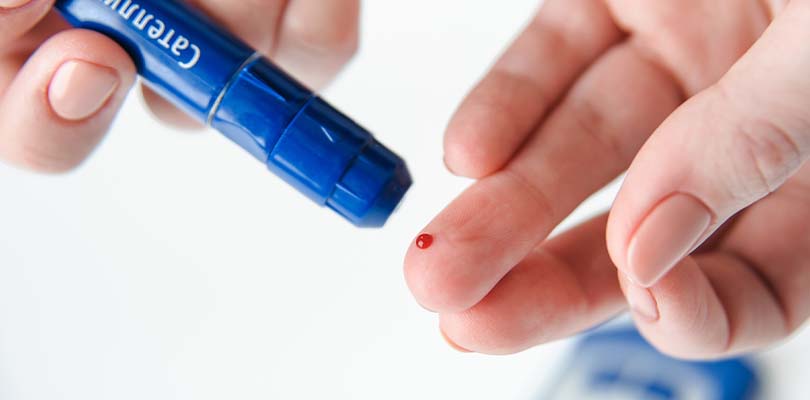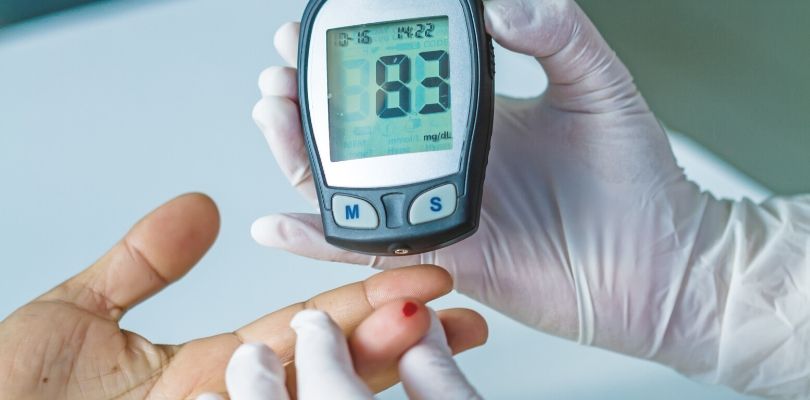Diabetic Meal Planning 101: What Is a Diabetic Meal Plan?
If you do a Google search, “diabetic meal plan” will be swimming with results. In fact, when I typed in “diabetic meal plan” the top result was “The Best 7-Day Diabetes Meal Plan.” My question is – who decides what the best meal plan for you is?
According to the American Diabetes Association, “evidence suggests that there is not an ideal percentage of calories from carbohydrate, protein, and fat for all people with diabetes. Therefore, macronutrient distribution should be based on an individualized assessment of current eating patterns, preferences, and metabolic goals.”
Did your jaw just drop to the floor?
Yes, you read that right. This means that there is no hard-and-fast rule that states that everyone with type 2 diabetes should have X amount of carbohydrates.
Most people think that there is a “right” amount of carbohydrates they should be eating, that there is a “magic” number. If there is, we haven’t discovered it yet.
Diabetes and Diets: What's Recommended?
The American Diabetes Association even says, “A variety of eating patterns are acceptable for the management of diabetes. The Mediterranean, Dietary Approaches to Stop Hypertension (DASH), and plant-based diets are all examples of healthful eating patterns that have shown positive results in research, but individualized meal planning should focus on personal preferences, needs, and goals.”
The Mediterranean Diet and the DASH diet are very helpful and can be utilized as a basis, but if you’d like to gain individual insight into the best diet for you, seeking a visit with a dietitian can prove most helpful.
Medical nutrition therapy, or MNT, is delivered by a registered dietitian (RD), who is skilled in diabetes – some even are certified diabetes educators (CDEs). MNT can seem daunting – after all, you may think that your life is going to change completely!
However, the American Diabetes Association notes that people who meet with an RD for MNT see large A1c reductions – 1-1.9 percent in those with type 1 diabetes, and 0.3-2 percent in those with type 2 diabetes.
How a Meal Plan Can Help Control Blood Sugar Levels
Sure, you could certainly attempt to control your glucose levels on your own after being diagnosed with diabetes. I’ve chatted with numerous people who have been very successful in controlling their glucose levels on their own, following a diet plan of their own devising.
And that is completely fine too!
Should you choose to meet with an RD for MNT, the MNT is, of course, designed to help control your glucose levels. That’s why you’re there, right? However, MNT for the diabetic patient also has other benefits as well!
According to the ADA, the goals of MNT for adults with diabetes are as follows:
- Promote healthy eating patterns while eating a variety of nutritious foods that are appropriately sized. Doing this helps to maintain health while also:
- Reducing weight and/or maintaining weight.
- Controlling glucose levels, as well as lipids and blood pressure.
- Prevent diabetic complications.
- Address each person’s individual needs as discussed above, in addition cultural and personal preferences, health literacy, and barriers, such as willingness to make a change in their health.
- Maintain the pleasure of eating.
- Provide tools for the development of healthy eating patterns rather than focusing on a single macronutrient.
Does that mean that because you enjoy pizza, because it gives you pleasure, you should eat that, as it is one of the goals of MNT? Well, sometimes! But not so fast, my friends!
What Should Be Included in a Diabetic Meal Plan?
Remember that term that we’ve used a couple of times – macronutrients? Let’s talk about it in a little bit greater detail.
Macronutrients are the “big guys” in our diets – carbohydrates, proteins, and fats. All are equally important because they have jobs to do in our bodies. We need them for survival. However, eating too much (or too little) of any of them isn’t that great either.
Carbohydrates
Carbohydrates intake is typically important to monitor for those with diabetes. Why? Because it can directly impact your glucose level.
Although this is a very simplified explanation – overeating can cause hyperglycemia (high glucose) and eating too little can cause hypoglycemia (low glucose) – although this is most likely to occur if you are taking insulin or a sulfonylurea.
There is no “magic” number of carbohydrates that should be eaten to maintain glucose. At a session with a dietitian, you may learn how to carbohydrate count. The RD may have prescribed a certain amount of carb choices to consume with each meal.
You’re probably thinking, “Well, why is this author telling me there isn’t a magic number if my RD just told me to eat four carb choices with my meals?”
Here’s why…
According to the ADA, “Most individuals with diabetes report a moderate intake of carbohydrate (44–46 percent of total calories)… the recommended approach is to individualize meal plans to meet caloric goals with a macronutrient distribution that is more consistent with the individual’s usual intake to increase the likelihood for long-term maintenance.”
What this basically means is that RD used a formula to calculate how many carb choices you should start with because following a plan increases your chances of success.
This can also be tweaked if it doesn’t work to achieve your glucose goals.
Although diabetic foot problems may not immediately spring to mind, for reasons to control your sugar, they should be at the top of your list of concerns.
Protein
Protein is another macronutrient that should be individualized to each person’s personal needs.
For example, some people may enjoy a higher satiety if they eat a higher protein diet, whereas those with reduced kidney function may need to have their protein needs to be reduced.
It is also important to note that carbohydrate sources that are also high in protein can increase insulin response – for this reason, these carbohydrates should not be used to treat hypoglycemia.
Fat
Fat is another macronutrient that should be individualized to each person’s needs. The “right” amount of fat has also been highly controversial lately due to the advent in popularity of diets such as the Atkins diet and the ketogenic diet. As such, the National Academy of Medicine has stated that a general distribution of fat for most individuals is 20-35 percent of total calorie intake.
If you’re wondering what type of fats are best to consume in the diet, the verdict is still out and research changes often. However, current research is leaning towards a Mediterranean diet. This diet limits saturated fats and are rich in mono- and polyunsaturated fats. This style of eating seems to improve blood lipids as well as glucose levels.
What about fat supplements? It seems like everyone takes a fish oil supplement these days! Unless your physician recommends otherwise, the ADA states, “A systematic review concluded that dietary supplements with n-3 fatty acids did not improve glycemic control in individuals with type 2 diabetes. Randomized controlled trials also do not support recommending n-3 supplements for primary or secondary prevention of CVD.”
And everyone agrees… no one (especially not those with diabetes!) should consume trans fats.
Type 1 Diabetic Meal Plan versus Type 2 Diabetic Meal Plan
Is there a difference in the dietary needs for people with type 1 diabetes?
This is the classic “yes and no” answer.
Someone with type 1 diabetes also needs to be adherent to monitoring their glucose. For this reason, they also need to be mindful of the amount of carbohydrates they consume. They also have similar risk factors for the development of hyperlipidemia and hypertension, so adhering to a healthy diet can prevent these from occurring.
That being said, people with type 1 diabetes are reliant on insulin for glucose metabolism. This means that they must take insulin for all of the carbohydrates that they consume.
Should they limit their carbohydrates? It depends on the person, their risk factors, their health in general. But should they choose to eat a large pizza and a slice of cake after, they can do so if they count their carbohydrates appropriately and administer the correct amount of insulin (although I don’t recommend anyone really eat that amount of food in one sitting!).
There are a variety of treatment options for type 2 diabetes – diet, exercise, oral medications, injectable medications, insulin. How you treat your diabetes will be dependent on your individual needs. Thus, your dietary needs will also be individualized.
The ADA states, “Individuals with type 1 or type 2 diabetes taking insulin at mealtime should be offered intensive and ongoing education on the need to couple insulin administration with carbohydrate intake.”
Remember the MNT we discussed? This is helpful for people with either type 1 or type 2 diabetes who require insulin to manage their glucose.
What About Low Carb Diets?
Who hasn’t heard of the Atkins diet or the ketogenic diet?
Crickets in the audience, am I right?
You may be surprised to know that the ketogenic diet was designed in 1923 by Dr. Russell Wilder at the Mayo Clinic. Another physician at Mayo Clinic, Dr. Peterman, standardized the diet, and it was used to treat epilepsy! In that time, there were no antiepileptic medications, and this fat-rich diet has proven itself very effective in treating seizures.
The Atkins diet is a modified ketogenic diet. Created by Robert C. Atkins in the early 1970s, the diet also limits carbohydrates in varying amounts.
Are these diets “right” for people with diabetes? It is hard to say. The ADA notes that the role of a low carbohydrate diet to maintain glycemic control is unclear.
The ADA says, “While some studies have shown modest benefits of very low–carbohydrate or ketogenic diets (less than 50-g carbohydrate per day), this approach may only be appropriate for short-term implementation (up to 3–4 months) if desired by the patient, as there is little long-term research citing benefits or harm.”
The Bottom Line…
You would think that there would be a hard-and-fast diet to manage glucose, right? After all, we’re able to vaccinate cervical cancer, and we have antibiotics that can eradicate infection, we can vaccinate against bacteria… but we can’t figure out a way to eat to control glucose?
Unfortunately, that is the truth. Your best bet is to ask your healthcare provider to refer you to an RD for medical nutrition therapy (MNT). Ensure that the RD is skilled in diabetes – this RD can help individualize your “plan” so that you can eat the way that you want, while still achieving your goals.







